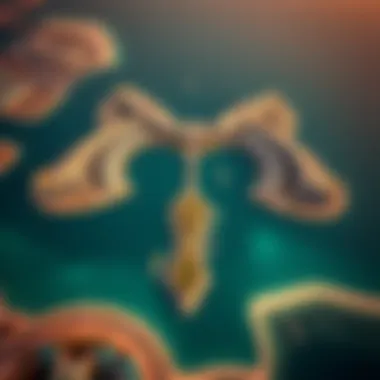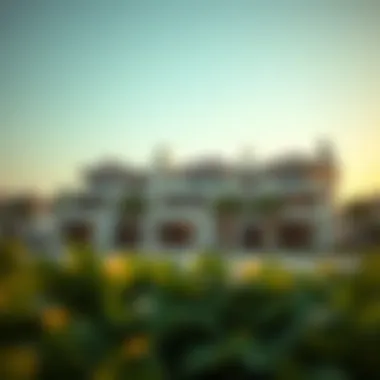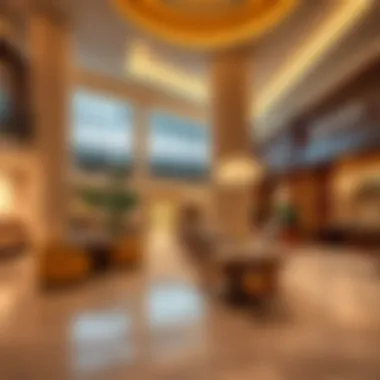The Palm Jumeirah: A Detailed Overview of Dubai's Landmark


Market Insights
The Palm Jumeirah stands as a testament to Dubai's ambitious vision for urban development, effectively becoming a symbol of luxury and innovation. To navigate the complex waters of the Dubai real estate market, one must understand the current trends shaping it.
Current Trends in Dubai Real Estate
At present, the market for real estate in Dubai is evolving rapidly. Buyers are showing increased interest in waterfront properties, with the Palm Jumeirah leading the charge due to its stunning views and unique lifestyle offerings. Luxury apartments and villas are in high demand, appealing to both expatriates and investors seeking a slice of paradise.
Demand is driven not only by local buyers but also by a growing influx of international investors. As of late, there’s been a significant rise in transactions, which indicates a recovery and growing confidence in the market. The rental market also reflects this trend, particularly for luxury properties, which can command premium rents. Properties here have an average rental yield ranging from 5% to 7%, depending on their location and amenities.
Some factors contributing to these trends include:
- Economic Diversification: The Emirate’s efforts to diversify its economy are paving the way for stability in real estate.
- Tourism Recovery: A boost in tourism post-pandemic has spurred demand for both residential and holiday rental properties.
- Foreign Ownership: New regulations allow for easier foreign ownership of properties, enticing more investors from around the globe.
Forecasting Future Market Changes
Looking ahead, several market changes are anticipated. Analysts predict sustainable growth in property values, fueled by continued demand for properties on the Palm Jumeirah. Specific indicators suggest that:
- Infrastructure Developments: Enhanced transportation links, such as the expansion of the Dubai Metro, will increase accessibility and consequently drive up property values.
- Luxury Market Growth: As the global wealth disparity widens, luxury real estate is set to remain a safe investment, with high-net-worth individuals seeking exclusive properties.
- Sustainable Living: There’s a shift towards eco-friendly developments within real estate, attracting environmentally conscious buyers and investors.
"The Palm Jumeirah is not just a luxurious destination; it represents the future of real estate in a city that adapts and evolves steadily."
Investment Strategies
For those looking to take the plunge into the real estate market of the Palm Jumeirah, understanding investment strategies is essential. Investment in this area isn’t just about purchasing a home; it's about making a well-informed long-term decision.
Tips for First-Time Investors
- Research Thoroughly: Knowing the ins and outs of Palm Jumeirah—what's available, pricing trends, and future developments—will help you make informed decisions.
- Engage Local Experts: Connecting with local real estate agents can provide insights only an insider would know, such as the most sought-after neighborhoods or upcoming projects.
- Consider Future Resale Value: Look at developments that not only appeal to you now but will likely appreciate over time. Choose properties with unique features or those located near planned amenities.
Understanding ROI in Dubai Properties
Understanding your return on investment (ROI) in this market is crucial. Generally, properties that are more centrally located or offer luxurious amenities tend to yield better returns. Key factors to keep in mind include:
- Location: Proximity to tourist attractions or business hubs will influence rental prices and occupancy rates.
- Property Management: If you plan on renting, consider professional management services to maintain your property and handle tenancy efficiently.
- Market Conditions: Keeping an eye on market cycles can help you time your entry or exit from investments effectively.
For more detailed analysis and up-to-date statistics on Dubai’s real estate market, check out resources from the Real Estate Regulatory Agency (RERA) at rera.gov.ae or the Dubai Land Department at dubailand.gov.ae.
In summary, engaging with the opportunities presented by Palm Jumeirah's real estate landscape requires a judicious approach. It's not just about luxury; it reflects a broader economic narrative that holds potential for both individual and communal growth.
Prolusion to Palm Jumeirah
The Palm Jumeirah stands as one of the most remarkable architectural feats of the 21st century, transcending mere geographical boundaries to become a symbol of ambition and innovation. Nestled off the coast of Dubai, this man-made island not only reshapes the shoreline but also redefines the luxury living experience. Significant from a cultural and economic standpoint, it serves as a hub attracting tourists, expatriates, and investors alike. Understanding Palm Jumeirah is not merely about gazing at its palm-shaped silhouette or luxurious offerings; it is essential to grasp its historical context and architectural prowess to fully appreciate its impact on the global real estate stage.
Historical Context
The inception of Palm Jumeirah can be traced back to the ambitious vision set forth by the government of Dubai in the 1990s. With the aim to diversify the economy away from oil dependence, a bold plan emerged to transform the coastal landscape. Designed by the mastermind architect and developer, Kerzner International, the project commenced in 2001. This initiative was not just a project; it was an endeavor to establish Dubai as a premier destination for tourism and expatriation. Amidst early concerns about sustainability and environmental impact, the project surged on, paving the way for the triumph of modern engineering.
"The Palm Jumeirah has turned the idea of a vacation home into a lifestyle, showcasing the apex of development and residential living in the Middle East."
In the years since its creation, Palm Jumeirah has undergone more than just physical expansion; it has merged cultural significance with economic strategies. The island attracted global attention, culminating in spectacular events and even hosting high-profile tourists, thus cementing its place on the world map.
Architectural Significance
Architecturally, the Palm Jumeirah is nothing short of a marvel. Spanning over 560 hectares, the island boasts cutting-edge designs that merge luxury with functionality. Each villa, apartment, and hotel is designed to provide a stunning view of the azure Arabian Gulf, harmoniously integrating natural elements with man-made geography.
The innovative design of the Palm not only emphasizes aesthetic appeal but also prioritizes the area’s ecological balance, with local flora integrated into the landscape design. Additionally, the construction employed state-of-the-art technology and materials, providing long-term durability and resistance to the elements.
This extraordinary design has earned the Palm recognition in architectural circles as it showcases how ambition can reshape environments. With its array of beachfront properties, luxury resorts, and opulent recreation areas, the island reflects an idea of living that is aspirational and attainable, all at once.
Emphasizing the engineering prowess involved in the project, firms such as Belgian contractor Van Oord and a plethora of local and international companies played pivotal roles in navigating the complexities of the construction process.


In summary, both the historical context and architectural significance of Palm Jumeirah underscore its importance, not just within Dubai but in the larger narrative of urban development. Its story is a multifaceted one—one that deserves thorough exploration.
Development and Construction
The Development and Construction of Palm Jumeirah stands as a testimony to human ingenuity and ambition, embodying a true engineering marvel against the backdrop of a desert landscape. This section delves into how the initial vision, meticulous planning, and robust execution transformed an audacious dream into a tangible reality. Understanding these elements provides insight into the broader economic and societal impacts the project has had on Dubai and the real estate market.
Initial Vision and Planning
The roots of Palm Jumeirah lie in the visionary aspirations of Dubai's leadership, particularly Sheikh Mohammed bin Rashid Al Maktoum. The conception of an island shaped like a palm tree was not just about creating luxury real estate, but about redefining the limits of architecture and urban planning. This ambitious venture aimed to position Dubai as a global hub of tourism and leisure.
From its earliest stages, the planning process was intensive. It began with meticulous studies regarding design feasibility and environmental impacts. The concept called for a balance between aesthetic appeal and ecological preservation, reflecting a thoughtful approach that didn’t compromise nature for development.
Key considerations during planning included:
- Impact on biodiversity: Ensuring the surrounding marine life and ecosystems were preserved.
- Market analysis: Understanding global real estate trends to anticipate demand.
- Infrastructure development: Laying out efficient transport, utilities, and services was crucial for the island’s integration with the mainland.
The initial blueprints proposed a blend of high-end residences alongside luxury hotels and leisure facilities, setting the stage for Palm Jumeirah's later success.
Construction Phases
The construction of Palm Jumeirah occurred in several phases, each marked by significant milestones that reflected the ambition of the project and the resilience of the workforce.
Phase One: Land Reclamation. This stage involved the monumental task of reclaiming land from the sea. The process, initiated in 2001, required millions of tons of sand and rock, and included a hefty investment in specialized dredging equipment. Over a period of three years, the island's shape began to materialize, showcasing a remarkable feat of engineering.
Phase Two: Infrastructure Development. With the land in place, the next step was constructing the necessary infrastructure. Roads, utilities, and essential services needed to accommodate residents and tourists had to be built. It was a period known for its upheaval, where relentless excavation and construction became the daily rhythm of the site.
Phase Three: Development of Properties. This phase saw various developers introduced into the mix, building luxury villas, signature hotels, and high-end apartments. The focus shifted from land to real estate, making investment opportunities ripe for both local and international buyers. Each structure reflected a commitment to quality, luxury, and innovation, ultimately resulting in the iconic skyline that dazzles visitors today.
Challenges Faced
As with any grand project, the development of Palm Jumeirah encountered its share of challenges. Notably, the most pressing issues revolved around construction logistics, environmental concerns, and navigating economic fluctuations.
- Logistical hurdles: The remote nature of the construction site posed difficulties in transporting materials and labor. Coordinating such an extensive operation required careful planning and innovative solutions to ensure timely progress.
- Environmental scrutiny: As the project advanced, environmental activists raised alarms about the potential disruption to local marine ecosystems. Responding to these concerns required adjustments in planning and construction methods, which led to the incorporation of sustainable practices.
- Economic downturns: Global economic fluctuations posed threats to the timeline and financing of the development. The 2008 financial crisis hit hard, stalling many projects in Dubai, but careful management and strategic pivots helped maintain the viability of Palm Jumeirah.
"Palm Jumeirah is not just an island; it is an architectural odyssey that altered the very fabric of Dubai's landscape."
Economic Impact
The Palm Jumeirah stands not just as an architectural marvel but also as a significant catalyst for economic growth in Dubai. Its creation has ripple effects across various sectors, making it a vital case study for investors and analysts alike. The economic impact of the Palm Jumeirah encompasses multiple dimensions—real estate dynamics, tourism enhancement, and job creation, among others. Each aspect of this phenomenon merits deeper examination.
Influence on Local Real Estate Market
The infusion of luxury living options offered by the Palm Jumeirah has markedly shaped the local real estate landscape. Properties here range from prestigious villas to high-rise apartments, catering to a diverse clientele. This variation caters to different socioeconomic groups, promoting vibrancy in the property market.
- Property Appreciation: The unique location and luxury amenities offered by the Palm have resulted in substantial property value increases over the years. Buyers are often willing to pay a premium, viewing it as not just a home but an investment opportunity.
- Investment Potential: Many foreign investors see the Palm as a hotbed for lucrative returns, buoyed by high demand for both rentals and sales. This demand arguably has a trickle-down effect on adjacent areas, stimulating growth in markets surrounding the Palm.
As noted by real estate analyst Adam Smith, "The Palm Jumeirah is a shining beacon in the Dubai property sector, influencing trends that often reverberate through to the burbs."
Tourism Boost
Another significant benefit from the Palm Jumeirah is the monumental boost to Dubai's tourism sector. The charm of man-made islands is irresistible, attracting millions of visitors each year. Factors contributing to this tourism surge include:
- World-Class Attractions: Beyond residential spaces, the Palm boasts numerous hotels, entertainment venues, and attractions. For instance, the Atlantis hotel has become a landmark and a go-to for tourists, enhancing the overall appeal.
- Unique Experiences: Tourists flock to the Palm not only for the luxury but for unique experiences like beach clubs and water sports, effectively creating a year-round tourism model.
- Events and Festivals: Regularly hosted events on the Palm, including music festivals and cultural gatherings, draw large crowds and thereby fortify the tourism revenue stream.
Such a boost: "Creating places where people want to be is essential for economic growth. The Palm does this exceptionally well," states tourism expert Laura Greene.
Employment Opportunities
The economic impact extends into the job market as well. The Palm Jumeirah has created thousands of jobs in various sectors, from construction to hospitality. The employment landscape can be broken down further into:
- Direct Employment: Workers during the construction phase and in hospitality roles at luxury hotels, restaurants, and service providers have found quality job opportunities.
- Indirect Employment: The ripple effect can be seen in ancillary sectors as well, such as transportation services and retail outlets. Local businesses have flourished due to increased foot traffic and demand, thus creating additional job opportunities.
- Skill Development: The need for skilled labor in areas like hospitality has spawned various training programs and partnerships with educational institutions, enhancing the local skill set.
To summarize, the Palm Jumeirah fortifies Dubai's economy by reshaping real estate, enhancing tourism opportunities, and generating employment. Each facet contributes to a more robust and dynamic economic ecosystem. The Palm is, without a doubt, a quintessential exemplification of successful development in a bustling urban center.


For more on the economic implications of real estate developments, resources like britannica.com and wikipedia.org provide excellent background information.
Lifestyle and Amenities
The lifestyle and amenities offered by the Palm Jumeirah play a crucial role in its allure as a premier living space in Dubai. When people think of residing in such a remarkable location, they look beyond just the real estate, searching for a lifestyle that suits their aspirations and needs. The Palm is not merely about having a roof over one’s head; it encapsulates an entire way of living that combines recreational opportunities, vibrant communities, and specialized amenities. Therefore, the choices available in terms of residential options, leisure facilities, and social events hold substantial weight for potential investors and homeowners alike.
Residential Options
Villas
Villas in Palm Jumeirah stand as a testament to luxurious living. Designed with spaciousness and privacy in mind, these homes offer expansive layouts that cater to families looking for comfort. A notable characteristic of these villas is the stunning views they provide, often overlooking the azure waters of the Arabian Gulf.
Villas are a sought-after choice for many due to their exclusivity and the high-quality finishes that complement their designs. A unique feature of some of these villas is their private beach access, allowing residents to enjoy coastal living without leaving their property. While these advantages are significant, it should be noted that the price point for villas can be quite steep, which might deter some potential buyers.
Apartments
Apartments in the Palm Jumeirah provide an attractive option for those who prefer a more urban lifestyle while still enjoying island living. The apartments often boast modern designs and convenient access to essential amenities. Many complexes are equipped with shared facilities such as pools and gyms, appealing to younger buyers and expatriates.
The key characteristic of these apartments is their flexibility, offering various sizes to fit individual needs—from studios to multi-bedroom units. The ocean views available from many of these apartments enhance their desirability, providing a relaxed atmosphere. However, denser living arrangements may come with compromise in privacy, and some might find the noise of urban life less appealing.
Townhouses
Townhouses in Palm Jumeirah blend the best of both worlds: the spacious living associated with villas and the community vibe often found in apartment living. These units are generally designed for families or individuals wanting a mix of privacy and social interaction. The characteristic appeal of townhouses lies in their multi-level design, which often affords private outdoor spaces like gardens or terraces.
A unique advantage of townhouses is their built-in sense of community, often featuring neighborhoods with shared amenities, promoting interaction among residents. This setup can be particularly inviting for families seeking a friendly environment for their children. However, due to shared facilities, some may find that maintenance responsibilities can be more demanding compared to standalone villas.
Leisure and Recreation Facilities
Beaches
The beaches surrounding Palm Jumeirah offer an idyllic setting ideal for relaxation and recreation. Known for their pristine sands and clean waters, these beaches are not just locations to unwind; they are vital for promoting a healthy lifestyle among residents.
A key aspect of these beaches is the variety of water sports and activities available—from jet skiing to paddleboarding—making it a hotspot for adventure enthusiasts. However, it can get crowded, especially on weekends, and securing a peaceful spot can sometimes be a challenge amidst the excitement.
Shopping destinations
Shopping in Palm Jumeirah is far from a mundane task; it has become an experience in itself. The presence of upscale retail outlets and boutiques allows residents and visitors to indulge in luxury shopping without venturing far from home. A major draw of these shopping destinations lies in the blend of international brands and local artisans, creating a diverse shopping atmosphere.
The unique feature here is the integration of dining and entertainment options within shopping areas, making a day of retail therapy both enjoyable and multifaceted. Notably, if one is looking for bargains or local markets, the high-end nature of the Palm's shopping spots might feel limiting.
Dining experiences
Dining at Palm Jumeirah is an adventure through flavors, from high-end restaurants to casual cafes. The diversity of culinary options is impressive, catering to different tastes and budgets. A distinguishing feature of the dining scene here is the opportunity to dine with stunning views of the Gulf, enhancing the overall experience.
This selection of restaurants not only offers convenience but also fosters a social atmosphere, making it a popular choice for both families and expatriation gatherings. While the diversity is commendable, the price range might be on the higher side compared to other Dubai districts; however, the quality often justifies the cost.
Cultural and Community Events
Cultural and community events serve to strengthen the sense of belonging among Palm Jumeirah residents. Regular festivals and social gatherings provide platforms for residents to engage with one another, fostering connections that turn neighbors into friends.
Events such as seasonal festivals often celebrate local culture, further enhancing the community’s integration. This engagement adds value to the lifestyle, making it attractive not just for newcomers but also for long-term residents looking to build a home. Additionally, it’s worth noting that the varying schedules of these events might require some flexibility in property choices, aligning with individual lifestyles and interests.
Investment Opportunities
Understanding the investment opportunities within the Palm Jumeirah is crucial for anyone considering entering this vibrant and lucrative market. This magnificent man-made island isn’t just a sight to behold; it represents a wealth of potential for investors, ranging from real estate buyers to entrepreneurs seeking to tap into the luxury tourism market.
The appeal of investing in Palm Jumeirah comes down to several fundamental factors:
- Location, Location, Location: Nestled in the Arabian Gulf, the Palm Jumeirah enjoys a prime position, making it one of the most sought-after locales in Dubai. Its proximity to the city center and other key districts enhances its value, as well as its allure to expatriates and affluent tourists alike.
- Types of Properties: The real estate market here offers a plethora of options, from luxurious villas and townhouses to high-end apartments. Each property type has unique features that cater to different demographics, whether looking for a holiday home or a permanent residence.
- Return on Investment (ROI): Many investors have found substantial ROI through both property appreciation and rental income. Palm Jumeirah’s appeal as a tourist destination boosts property desirability, leading to higher rental rates, especially during peak seasons.
Real Estate Market Overview
The real estate landscape in Palm Jumeirah reflects Dubai's broader economic conditions, but it stands out thanks to its distinctive characteristics.


The market has generally shown resilience, recovering well from earlier downturns. Average property prices tend to fluctuate but have exhibited an upward trend in recent years. Current statistics indicate that:
- Average villa prices range from AED 5 million to AED 30 million, highlighting the diversity in luxury.
- Apartment prices can be seen as lower, starting around AED 1.5 million, making them accessible for smaller investors.
The market's dynamics are also influenced by ongoing developments and infrastructure enhancements, which continuously attract international buyers.
Buying vs. Renting Analysis
Making a decision between buying or renting in Palm Jumeirah requires understanding lifestyle goals, financial capabilities, and market conditions. Here’s a breakdown:
Buying
- Pros:
- Cons:
- Long-term investment potential with property appreciation.
- The advantage of customizing your space and building equity over time.
- High initial costs, including down payment and fees.
- Market fluctuations can affect resale value.
Renting
- Pros:
- Cons:
- Flexibility to move without the burden of selling.
- Lower upfront costs and fewer long-term commitments.
- Monthly rent can add up, affecting long-term savings.
- No equity building or control over property decisions.
"Real estate is more than just a roof over your head; it’s about crafting your future."
Financing Options for Investors
Navigating the financial side of investing in Palm Jumeirah may seem daunting, but several viable avenues exist for potential investors:
- Mortgages: Many local banks provide mortgage options for both residents and non-residents. It's essential to compare deals and ensure you understand interest rates and terms.
- Cash Purchases: If possible, a cash purchase remains the simplest route, avoiding complications with loans and interest.
- Partnerships and Syndicates: Investors can also consider joining forces through property syndicates, where multiple parties pool resources to invest in larger properties.
In summary, investment opportunities in Palm Jumeirah are not just confined to residential properties; they extend into commercial sectors and hospitality developments as well. The strategic vision for this area suggests a robust future economy, making it an engaging prospect for serious investors.
Future Developments and Trends
The ever-evolving landscape of Palm Jumeirah is a testimony to Dubai's ambition and innovative spirit. As the iconic landmark continues to draw interest from investors and tourists alike, future developments hold significant implications for its growth and sustainability. Examining these trends allows us to grasp not only the potential investments but also how they will contribute to the overall appeal of this extraordinary site.
Expansion Plans
The ongoing expansion plans for Palm Jumeirah are not merely about adding more buildings or attractions. Instead, they reflect a strategic vision to enhance the experiences of those who live, work, and visit the island. Major projects include the expansion of retail spaces and the introduction of new leisure facilities that cater to a more diverse population.
One noteworthy proposal involves the addition of themed resorts and entertainment venues akin to those found in competitive locales worldwide. This is not simply a bid for luxury; it’s a shift to position Palm Jumeirah as a global leisure destination. These plans aim to lure in a younger crowd, creating opportunities for new businesses while invigorating the existing community.
The End
As we draw to the end of our exploration of the Palm Jumeirah, it becomes clear that this man-made island is not just a marvel of engineering but a multifaceted symbol of Dubai’s rapid evolution and global stature. The significance of this subject is underscored by the complex interplay between its unique design, the driving force behind its economic contributions, and its influence on future real estate trends. Furthermore, this article seeks to illuminate the opportunities for investors and residents alike, revealing how Palm Jumeirah serves as a thriving microcosm of Dubai’s broader real estate landscape.
A major element lies in recognizing the role Palm Jumeirah plays in attracting tourists and permanently settled expatriates. High-end amenities, coupled with breathtaking views, underscore its desirability among various demographics, from vacation home buyers to families seeking luxurious residences. In light of its avant-garde construction technology, prospective investors can appreciate its landmark status, which facilitates both lifestyle enhancements and economic returns.
It’s hard to ignore the ongoing discussions on sustainability initiatives here, which further add layers to its significance. As Dubai positions itself towards a future that embraces ecological responsibility, the developments on Palm Jumeirah could well be a model for similar projects across the globe. This article ultimately sheds light on why discerning market players—investors, agents, and residents—should keep an eye on this remarkable island.
Recap of Key Insights
In summary, the insights provided throughout the article shed light on several critical aspects:
- Historical Context: Understanding the origins of Palm Jumeirah deepens appreciation of its place in Dubai's evolution.
- Economic Impact: The island's contribution to real estate and tourism is noteworthy, transforming local economies.
- Investment Opportunities: A thorough analysis of buying versus renting reveals a landscape ripe with potential for both profit and lifestyle advantages.
- Future Outlook: With expansion plans and sustainability initiatives underway, Palm Jumeirah stands on the cusp of future advancements, defining its role in tomorrow’s economy.
Final Thoughts on Palm Jumeirah
As we sum up this dialogue about the Palm Jumeirah, one cannot help but admire the audacity of its vision. Built on the belief that innovation thrived in the desert, its significance resonates far beyond the shores of Dubai. It represents a style of living and investment that speaks to many, encapsulating a lifestyle marked by luxury and comfort.
For potential buyers and investors, the island remains a jewel in the crown of Dubai’s real estate market. Investing in Palm Jumeirah is not merely about acquiring property; it's about being a part of a vibrant, evolving community that is synonymous with success. As the island continues to flourish, it surely offers a canvas rich with potential for creating unique experiences, both residential and commercial.
"In an age where real estate can often seem merely transactional, Palm Jumeirah invites individuals to dream bigger and invest in a lifestyle that thrives on luxury, artistry, and community."
Ultimately, whether you seek to relax by its pristine beaches or consider making an investment, Palm Jumeirah promises much in return, making it a cornerstone in the future of luxury living in Dubai.











